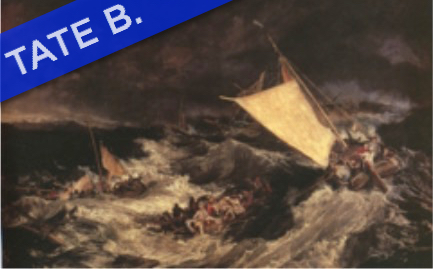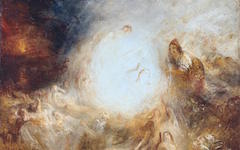Turner’s The Fifth Plague of Egypt (1800)
Simon Schama, the historian, writes somewhere in his book, The Power of Art, that Turner’s compositions are often eye-shaped.1 Others must have noticed this too. Sun in his pictures breaks through darkened clouds in an oval form, waves curve upwards, trees bend into the wind; nature – at least in Turner’s compositions – seems circular, oval, sometimes even a double-oval – as though there were two eyes – peering out of a landscape or out of the mist as it covers the sea. No-one seems to have noted, though, that, yes, those eye-shapes are “eyes”. The artist’s eyes. Turner’s art is set in Turner’s mind.

Left: Turner, Self-portrait at the Age of Sixteen, detail (1791-2) Indianapolis Museum of Art
Right: Turner, Self-portrait, detail (1799)
Click image to enlarge.
Even in Turner’s earliest self-portrait (far left), a precocious work done at the age of sixteen, he has dark circles under his eyes as he does in a later, though still youthful, self-portrait (near left). They appear to have become his trademark, like Michelangelo’s broken nose or Manet’s top hat and cane, motifs that identify the artist's presence.
Click next thumbnail to continue
The Fifth Plague of Egypt, painted one year after the second and last surviving self-portrait, was Turner's largest composition to date. It is a perfect example, two ovals of sunlight surrounded above, and even more so below, by darkness. The one on the left features a backlit mountain in the distance, the other a front lit castle wall.
Click next thumbnail to continue

Top: Detail of Turner's The Fifth Plague of Egypt (1800)
Bottom: Detail of Turner's Self-portrait (1799)
Click image to enlarge.
Compared to the artist's eyes in the slightly earlier self-portrait (bottom), the similarity is striking, the dark bags under his eyes echoed in the dark circular forms of the landscape beneath the oval patches of light. A highlight on the bridge of his nose may have been turned into the triangular side of a pyramid in sunlight. The ball of clouds on the right seems to repeat the curve of skin beneath and next to his eyebrow.
Click next thumbnail to continue

Turner, Snowstorm. Hannibal and His Army Crossing the Alps (1812) Tate Gallery, London
Click image to enlarge.
In an 1812 canvas entitled Snowstorm. Hannibal and His Army Crossing the Alps, the eye-shape is obvious with the filtered sun above as an inner eye. We are looking into a close-up of the artist's mind with Hannibal and his army struggling over the Alps as a metaphor for the artist's own struggle to create.
Click next thumbnail to continue

Turner, Snowstorm. Steam-boat off a Harbour's Mouth (c.1842) Tate Gallery, London
Click image to enlarge.
Thirty years later with a similarly titled painting - Snowstorm. Steam-boat off a Harbor's Mouth - we are in even greater close-up, with just a corner of the eye visible on the right. A dark cloud suggests a pupil. There is not space to illustrate all the many ways that Turner was able to transform his eyes into masterpieces of art but, at the very least, it is a start. Turner, we are told, "was a taciturn man who usually went out of his way to avoid explaining his pictures." 2 One can understand why.
Turner's method here is very close to one used by Rembrandt in his Landscape with a Stone Bridge. And for more on Turner's hidden visions, see our post on The Poetry of Turner's Eyesight.
More Works by Turner
Notes:
1. Schama, The Power of Art (London: Ecco) 2006
2. Eric Shanes, Turner’s Human Landscapes (London: Heinemann) 1999, p. 14
Original Publication Date on EPPH: 22 Sep 2011. | Updated: 0. © Simon Abrahams. Articles on this site are the copyright of Simon Abrahams. To use copyrighted material in print or other media for purposes beyond 'fair use', you must obtain permission from the copyright owner. Websites may link to this page without permission (please do) but may not reproduce the material on their own site without crediting Simon Abrahams and EPPH.



